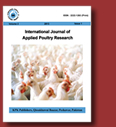|
Although residues from the antibiotics found in marine products were
originally examined as a pressing problem facing marine life, marine
bacteria’s resistance to antibiotics has recently come to the fore as a
central environmental issue. This study was conducted to examine
antibiotic resistance levels among different marine samples and to show
the connection between marine bacteria’s resistance to antibiotics and
their exposure to microplastics. Marine bacteria were collected from
coastal seawater, abyssal seawater, and coastal sand, and intestinal
bacteria were collected from deep-sea fish, coastal fish, shellfish, and
rotten fish; each of these samples of bacteria was tested for resistance
to four types of antibiotics (meropenem, streptomycin, penicillin, and
vancomycin). Among the types of bacteria collected from the coastal
sand, 87.1% to 100% showed resistance to one or more of the selected
antibiotics, and among the types of bacteria collected from the coastal
waters, 84.6% to 100% showed antibiotic resistance. In addition, when
the distribution of resistant bacteria was observed in intestinal
bacteria collected from coastal and abyssal fish, the intestinal
bacteria of abyssal fish had lower rates of resistance to antibiotics
than that of coastal fish; moreover, 100% of versatile resistant
bacteria (which showed resistance to more than three types of
antibiotics) found in the intestines of coastal fish were resistant to
antibiotics while, among abyssal fish, only 92% showed resistance. Among
the intestinal bacteria found in shellfish and decomposing fish except
for one type of sensitive bacteria, all types of bacteria were resistant
to vancomycin and meropenem. Finally, as a result of culturing
antibiotic-resistant bacteria with microplastics, 11 out of 12 types of
bacteria developed antibiotic resistance, showing that exposure to
microplastics can cause antibiotic resistance. Based on these results,
it can be concluded that microplastics contribute to the development of
antibiotic resistance among marine bacteria.
|

